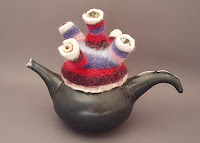It's that
time of year again. Test tiles.
You may recall, I've been working out ideas for a
new line of work for quite some time now. This past Christmas things finally came together and I unveiled
this new line at my recent wholesale show in Toronto.
Getting it ready for the show, unfortunately, was quite the ordeal. I was struggling to find a nice, clear, durable glaze that I could use with
this one that I had been working on a while back. I had a very specific color in mind and set about testing, testing, and testing some more to achieve it. Robin's egg blue. Maybe a bit more of the blue, less of the turquoise, but just to give you an idea. And I had an idea of where to start with my testing. Copper, maybe a fraction of a percent of cobalt to punch it to the blue side...
My guesses were pretty good and in my first batch of test tiles I hit the color I was looking for: 1% copper carbonate plus 0.1% cobalt carbonate. So I set about mixing up a slightly larger batch to get it on some work. It's always easier to get a real feel for a glaze by testing larger batches, rather than just mixing up a huge bucket from what you see on a test tile. Annnnnnd.... I'm glad I did.
Disaster. Super ICK. Bubbles! Everywhere, thousands and thousands of bubbles! My beautiful, clear, glossy glaze was dulled with a pitted surface and microscopic bubbles everywhere. Test tiles are far too small to get an accurate picture of what a glaze will do, and in this case, what the glaze did on a plate, was much different that what it did on a tile.
So. I hit the books. Copper gives off gas after 1975' or so. (Don't quote me on that temperature though, I'm not sure exactly where it starts to get volatile). All that gas was getting trapped in my glaze, even with a hold at peak temperature. Okay. No problem. The carbonate form of copper can release more gas that the oxide form so I mixed up some more tests, using 0.65% copper oxide instead of the carbonate. (The oxide is a stronger colorant). But alas, the bubbles persisted.
Okay. No problem. Tinker with the glaze recipe a bit and I should be able to fix that, right? Working with my
Insight program, I tried adding 2% lithium carbonate to the glaze as a way to smooth out the surface. And it worked! But now instead of a beautiful, clear glaze, I had a beautiful, variegated glaze.
Okay. No problem. Back to the Insight program. I removed the lithium and decided to tackle the alumina. I was able to lower the alumina content of my glaze to make it a bit runnier, the idea being that if the glaze flows and moves better, those pesky little bubbles will be able to escape.
Annnnnd, it worked! but now I had yet another problem. Boron clouding. Ugh. The alumina keeps the glaze stiff which prevents boron crystals from forming. Without the alumina, the crystals were able to grow. That means, no clear glaze for me.

With the clock ticking and me needing to resolve this issue, I turned to stains. Yes.
Stains. Something I had sworn I would never use. Something I had always considered as a form of cheating. With my head hanging low, I ordered several different shades of what looked like promising colors and went back to mixing up test batches.

The first bunch of tests gave me an idea of how each stain looked. From there, I was able to put together some blends that I thought would push the color to where I wanted it. And as luck would have it, the next batch gave me just what I was looking for.

Actually, it gave me better than what I was looking for. I have a whole new respect for those stains, let me tell ya'. And I may just be turning to them a lot more in the future.
And as for that new line of work...
You may be wondering why it's so different from where my tests began so many months ago. What can I say? There's no telling where creative adventures will take us. I can say, however, that I'm really pleased with how the new line looks!









